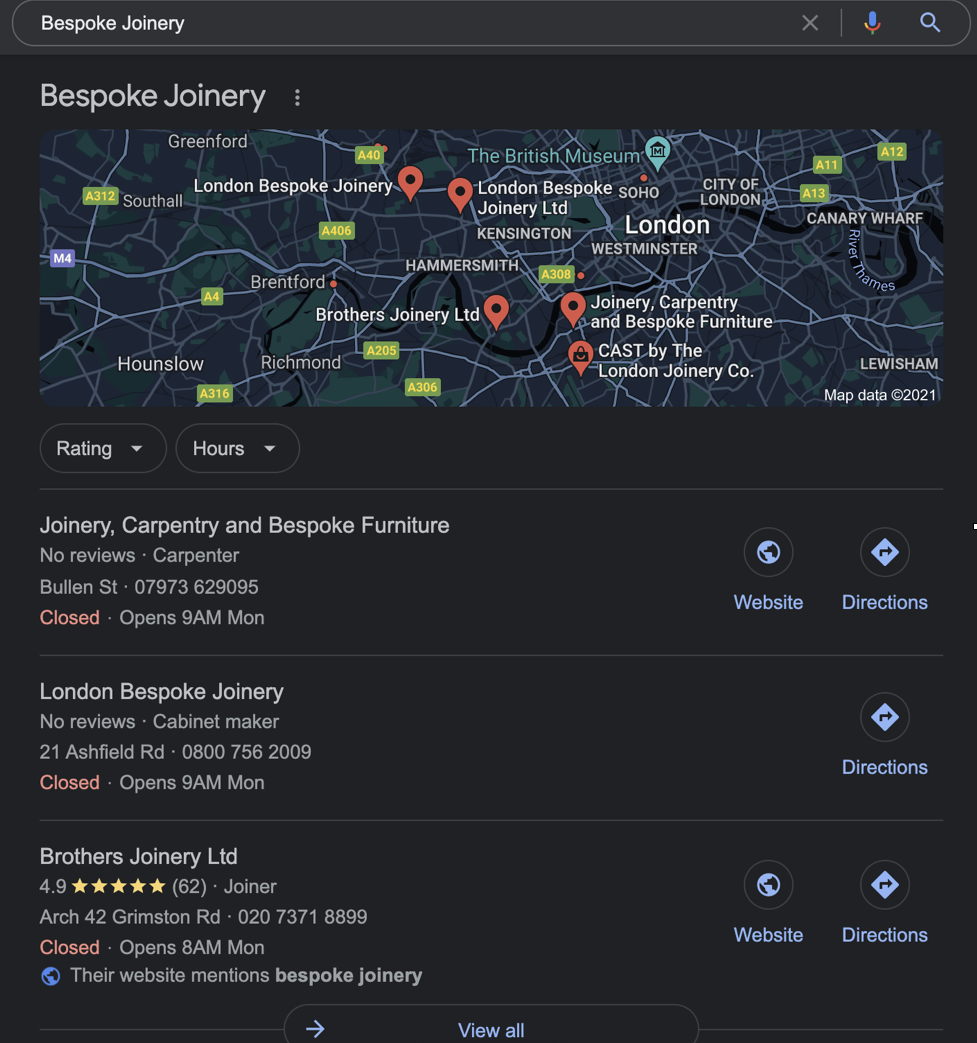Search engines have come a long way since their inception. Long gone are the days where a basic query would return multiple low-quality websites, where searching for a restaurant would display results from the other half of the globe, and where you could easily use grey-hat and black-hat techniques to game the algorithm and get your website on top of SERPs (search engine results pages).
Their algorithm is far more sophisticated nowadays, and it returns completely different SERPs depending on user intent, search history, location, and more, but for this article, we’ll zero in on one particular type of search that’s vital for businesses: local search.
What is Local Search?
Defining what is a ‘local search’ precisely can be hard — there’s no consensus. Broadly speaking, however, a local search is a query where the user ‘intends’ to find information specific to a locality. These broadly fall within three types of queries:
- Queries explicitly including a geographic area: these include searches like “restaurants in Seattle”, “tacos in Austin,” etc.
- Queries including phrases like “close by”, “near me,” etc.
- Queries Google infers are local: typing “Chinese food” into Google on your phone will likely bring up local results because Google infers the intent. This is the case for a plethora of other queries.
In each of these cases, if Google/Bing doesn’t take the user’s location into account, its SERP would be largely useless.
Why is Local Search Important?
Despite our increasingly globalized world, business is still mostly done on the local level, and certain businesses like catering, plumbing, etc. are still exclusively local. But this is just the tip of the iceberg:
- According to a survey by Ipsos done on behalf of Google, 4 in 5 customers use search engines to find local information. 50% visited a store within a day of conducting a local search on their smartphones. The figure stands at 34% for those who own a PC/Tablet. Local searches are 2.5 times more likely to lead to a purchase than non-local searches.
- According to Forrester, mobile devices alone influenced more than 1 trillion in offline sales in 2016, and they predicted that figure will rise to 1.4 trillion by 2021.
- According to a 2019 Google report, local searches with phrases like ‘where to buy’ & ‘near me’ grew by 200% on smartphones from 2017 to 2019 with the trend continuing strong.
These stats not only show that the local search market is massive and could be an essential source of revenue for your business, but it also indicates that it still has a lot of potential for growth.
I hope all these stats convinced you of the importance of local searches, because in this article, I’ll teach you how you can improve your website’s position in local searches.
Local Packs: Everything You Need to Know
Before we start going into how you can improve your website’s positions on SERPs, there’s one additional concept we need to cover: local packs.
Over the last few years, Google has added many new ways of displaying results: FAQ sections, video snippets, galleries, and most importantly, local packs.
You’ve probably seen local packs before. When you enter a query with local intent, Google usually displays a map alongside three results of nearby locations in a box:

They are displayed prominently at the top of the SERP with organic searches trailing behind. A significant number of users will pick one of the three options instead of scrolling down to localized organic searches, which is why it is vital to target them as well.
How to Improve My Company’s Position in Local Searches?
Improving your business website’s position should be relatively straightforward: you just need to learn what impacts your ranking and improve on it. There’s only one issue, though: the algorithm Google uses to determine where you rank on local packs is different from the one they use to determine where you rank for localized organic search results. And since you ideally want to rank high on both, creating an SEO strategy will be a balancing act.
Thanks to researchers at Brightlocal, though, we have robust data showing how Google weighs different factors when ranking pages for local packs and organic search results, and we’ve created these two handy pie charts to show the evolution of both during the past 7 years.
As the graph clearly shows, the four most important ranking factors for localized organic search in 2020 are (in descending order): link, on-page, behavioural, and personalization signals.
As for local packs, the four most important ranking factors in 2020 are (in descending order): Google My Business, review, link, and on-page signals.
Paying attention to these two facts from the graph will be essential in creating the right SEO strategy and celebrating it over time:
- Google My Business and review signals are vital if you want to rank for local packs, but they’re not that important for organic search.
- Regardless of whether you want to rank for organic search or local packs, you need to get on-page and link signals right: they’re essential.
For the remainder of this article, we’ll go over the essential signals in order, describe what they are, and give you tips and strategies your business can leverage to get on top.
#1 Link Signals
The most important item on the list, link signals are broadly measured by the inbound links pointing to various landing pages on your website. The quantity isn’t only what matters here, but the quality as well. Getting an inbound link from The New York Times will do a lot more for your website than getting an inbound link from a blog with no authority. You can check your website’s backlink profile and see how you’re doing with excellent tools like SEMRush’s Backlink Analytics.
The entire concept of the Google search engine was built around backlinks, and they continue to be important to this day. Link signals are vital factors in both localized organic search (31%) and local pack (15%) rankings. Sadly, building a good backlink profile takes a lot of time and money: you need to outreach to websites, reach out to industry leaders, and build connections.
It is understandable if all this sounds like a chore to you, but given how essential it is to SEO success, you can’t forgo it. So, if you don’t have the time, money, or skills necessary to build backlinks, I recommend delegating the backlink building work to a competent agency.
#2 Google My Business Signals
Initially introduced in the early 10s, Google My Business (GMB) is a place where you can add your business, its location, services, opening hours, and more to Google databases. GMB has taken on an ever-increasingly important role in Google’s algorithms and strategies. Just a glance at our pie chart will tell some of the story: Google My Business signals’ weight has gone from 23% in 2013 to 33% in 2020 — this is a substantial increase.
If you haven’t registered your business yet, the first thing you need to do is register your business on GMB: it is free, simple, and takes about 5 minutes. Beyond that, improving your business’s GMB signals will include continued work refining categories, adjusting keywords in the title, making sure your profile is complete, and more. Thankfully, the job isn’t exactly complex or technical, so you should get it right after some tinkering and measuring performance.
#3 On-page Signals
Arguably tied in importance as a ranking factor with link signals, on-page signals refer to a slew of diverse elements on your website that broadly impact your ranking on SERPs:
- The inclusion of your business’s name, phone, and address (NAP) (vital for local searches)
- Proper use of keywords in titles, headings, and the body of your landing pages.
- Proper and navigable landing page structures.
- The quality of the content on your landing pages.
- The technical competency of the website: loading times, responsiveness, etc.
As with link signals, on-page signals are numerous, complex, and require both time and expertise to get right. Also, like link signals, on-page signals are vital for the success of your efforts weighing in at 32% for organic search and 15% for local packs. Thankfully, there are excellent tools that help you streamline the on-page optimization process like Senuto.
#4 Review Signals
Google reviews have become increasingly important, and not just for users, but for Google’s search algorithm itself. Google picks up various review signals from the quantity of the reviews, the quality of the reviews, the history of the reviewers, the numerical rating of your business, and more.
Weighing in at 16% for local packs and 6% for localized organic searches, review signals might not be the most important out there, but they still have a meaningful impact (especially for local packs), and if you’re trying to rank for competitive keywords, you can’t neglect this aspect of SEO.
Summary
Having worked for over two years at Neadoo, we’ve helped tens of clients from various industries dominate their local searches. Working with them, I noticed the same misunderstandings and misconceptions surface again and again, and this is why I decided to write this primer helping businesses understand local SEO just a tiny bit better.
Ranj Omer - Senior Content Writer @Neadoo Digital


